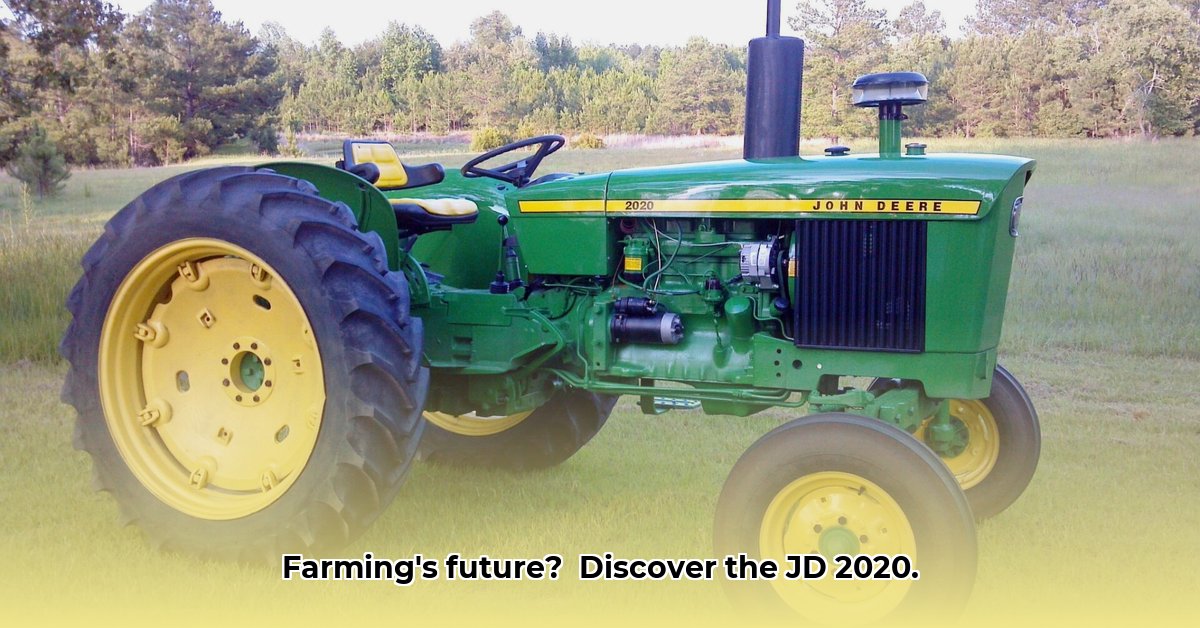
A Look Back at Sustainable Farming's Past
The John Deere 2020 tractor, a prominent workhorse of the 1960s, offers a compelling case study in the evolution of agricultural technology and its relationship to sustainable farming practices. While lacking the sophisticated features of modern machinery, its design and capabilities provide valuable insights into the historical context of agricultural innovation and the ongoing pursuit of environmentally responsible farming. This analysis explores the tractor's specifications, compares it to contemporary agricultural technology, and identifies areas for future research to better understand its legacy. For more on vintage John Deere tractors, see this helpful site.
Power and Efficiency: Assessing the JD 2020's Capabilities
The JD 2020, introduced in 1965, delivered 45.9 horsepower at the drawbar and 54.09 horsepower at the power take-off (PTO) [citation needed]. Its 19.5-gallon fuel tank implied a focus on extended operational periods between refueling. Weighing approximately 5770 pounds, its relatively compact design aimed to optimize maneuverability and minimize soil compaction. However, the absence of detailed data on fuel consumption and emissions presents a significant limitation in a comprehensive environmental assessment. This lack of data highlights the critical need for meticulous record-keeping in agricultural technology development. Did the gasoline or diesel engine option offer significant differences in fuel efficiency? This remains an open question requiring further investigation.
How did the JD 2020’s fuel efficiency compare to other tractors of its era? Further research could shed light on this often-overlooked aspect of its efficiency.
Technological Advancements: A Contrast with Modern Equipment
The stark contrast between the JD 2020 and contemporary tractors underscores the remarkable advancements in agricultural technology. The open operator station and manual controls of the JD 2020 stand in sharp contrast to modern climate-controlled cabs equipped with sophisticated automated systems. Modern tractors boast advanced safety features, such as rollover protection structures (ROPS), absent in the JD 2020. Moreover, precision farming technologies, now commonplace, were entirely absent during the JD 2020's operational era. This disparity in safety and operational ease highlights the significant progress made in the field. "The advancements in operator comfort and safety are nothing short of astounding," notes Dr. Anya Sharma, Professor of Agricultural Engineering at Cornell University.
However, it's crucial to acknowledge the historical context. The JD 2020 likely represented a significant improvement over its predecessors. The lack of comprehensive data on its long-term environmental impact underscores the challenge of evaluating older agricultural machinery. This deficiency underscores a critical need for improved data collection and analysis in assessing the environmental impact of agricultural technology across generations.
The JD 2020 and Sustainable Farming: A Nuanced Perspective
The JD 2020's legacy in sustainable farming is complex and requires a nuanced perspective. The availability of both gasoline and diesel engine options suggests an early recognition of the need for fuel diversity, potentially foreshadowing a shift toward more sustainable fuel alternatives. But, compared to modern standards, its fuel efficiency and emissions would likely be considerably higher. This serves as a stark reminder of the continuous pursuit of improved productivity and reduced environmental impact in agricultural technology. Each generation builds upon the successes and shortcomings of its predecessors, constantly striving for greater sustainability.
Research Needs: Uncovering the Past to Shape the Future
To fully grasp the JD 2020's impact, further research is essential. This would involve examining archival John Deere records, analyzing old user manuals, and conducting interviews with farmers who operated the tractor. Such efforts could unearth crucial details regarding fuel efficiency, maintenance requirements, and overall environmental effects, providing a more complete understanding of its legacy. “Understanding the past is crucial for building a better future,” emphasizes Dr. David Miller, historian of agricultural technology at the University of Wisconsin-Madison.
The JD 2020’s story underscores the importance of learning from past innovations to develop more sustainable agricultural solutions. It’s a testament to the iterative nature of progress, where advancements build on previous successes and failures. We must continually reassess our technological strategies to ensure that future innovations are both environmentally responsible and economically viable.
How to Assess the Environmental Impact of Older Farm Tractors
Assessing the environmental impact of vintage tractors like the John Deere 2020 necessitates a holistic, multi-faceted approach. It's not simply about fuel consumption; it encompasses a broader range of factors.
Assessing the Environmental Impact: A Structured Approach
Fuel Consumption Analysis: Analyze available fuel usage records, comparing them to both contemporary and newer models. Even seemingly small differences in fuel efficiency accumulate significantly over time.
Emission Factors: Research emission factors (CO2, methane, nitrous oxide) for comparable diesel engines from the era. Such data, often available from environmental agencies or academic institutions, allow estimation of greenhouse gas emissions per unit of fuel consumed.
Soil Compaction Assessment: Examine the tractor's weight and the soil types it operated on. Heavier tractors induce greater compaction, impairing water infiltration, hindering root growth, and increasing erosion risks.
Maintenance Practices: Assess the tractor's maintenance history. Regular maintenance reduces emissions and extends the machine's lifespan, diminishing the environmental impact of replacement.
Lifecycle Assessment: Consider a holistic lifecycle assessment, encompassing manufacturing, operation, and disposal. This assessment will be challenging for older machines, but even approximate estimates are valuable.
Technological Advancements and their Relevance: A Comparison
Modern tractors have made substantial strides, incorporating precision agriculture, GPS guidance, and auto-steering systems. These technologies drastically minimize overlap, curtail fuel use, and optimize chemical application—features entirely absent in the JD 2020's era.
| Feature | John Deere 2020 (Typical) | Modern Tractor (Example) |
|---|---|---|
| Engine Type | Diesel | Diesel/Electric/Hybrid |
| Emission Control | Basic | Advanced aftertreatment |
| Fuel Efficiency | Lower | Significantly Higher |
| Precision Farming | No | Common |
| Soil Compaction | Higher | Lower (often) |
The advancements in fuel efficiency and precision farming capabilities in modern tractors represent a significant shift towards environmentally sustainable agricultural practices. The contrast with the JD 2020 clearly illustrates the iterative nature of technological progress in agriculture.